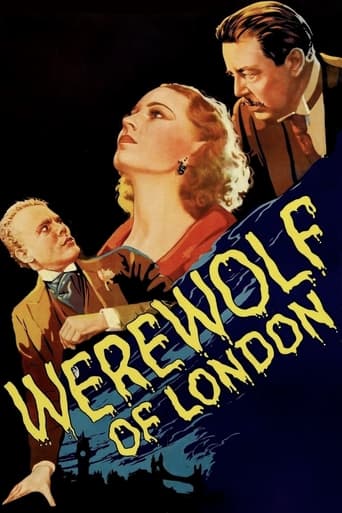

My thanks to IMDB for stopping their bad habit of replacing the original write-ups of films like this one with the "Svengoolie" episode number and NOTHING ELSE! For some time THAT was all you'd find when looking up a film like "Werewolf Of London" - just the Svengoolie episode number and NO other information. Let's face it, Friends - in the history of Cinema, whatever Svengoolie does just DOES NOT MATTER! What DOES matter is the actual information about the FILM!
... View MoreCopyright 14 May 1935 by Universal Pictures Corporation. Presented by Carl Laemmle. New York opening at the Rialto: 9 May 1935. U.S. release: May 1935. Australian release: 18 September 1935. 75 minutes. Canadian release title: UNHOLY HOUR. SYNOPSIS: Scientist is bitten by a werewolf whilst on an expedition in Tibet.NOTES: Following her debut in the 1934 The Path of Glory, Valerie Hobson journeyed to Hollywood where she starred in several important films such as The Mystery of Edwin Drood and The Bride of Frankenstein before returning to England. The lesser-known Werewolf of London was also a product of her Hollywood stay.COMMENT: Despite (and indeed partly because of) its clichés of dialogue, plot and situation, this is an entertaining entry in Universal's horror cycle. Walker's direction is stylish enough to give the lie to any notion that he is dull and unimaginative. Particularly impressive here is the transformation scene with Hull advancing diagonally towards the camera as it tracks behind pillars. The rapid fade-ins/fade-outs of the telephone reports are likewise effectively accomplished, and there's an extremely long take (early on in the picture) of which even John Farrow might have been proud. As the music score by Karl Hajos is rather pedestrian, Walker wisely relies only on sound effects in the film's more dramatic moments-of which there are many. Although Stumar's photography is otherwise impressive, Miss Hobson's heroine is not very flatteringly lit. Her acting, however, registers okay. Hull himself does a vivid job, but it's Warner Oland (taking time off from his Charlie Chan impersonations), who effortlessly walks away with the movie's histrionic honors. Produced on rather a lavish scale, Werewolf in London certainly doesn't lack action.
... View MoreWerewolf of London (1935) was a pleasant surprise, not that I wasn't expecting much from the first (mainstream) werewolf film, but I wasn't expecting it to be as good or better than the Wolfman (1941) and I will say that it managed to be on the same level of greatness.Perhaps not all of the actors do a convincing job and some scenes could be considered to be very poorly executed, but I will say that most of the film its quite good. This movie is also responsible for making up most of the werewolf myth, at least the more well known version of the myth.I also noticed the intentional similarities between this film and An American Werewolf in London (1981), more than just the name, they share many other elements, from the two men being attacked at the beginning of the film, to the very end.Overall, its a pretty great horror film, I would recommend it to horror fans, mostly because I don't think enough people have seen it, most people think of The Wolf Man when they think of classic werewolf movies, and with good reason, but this one also had a huge part in the genre.
... View MoreThis was a decent film from the time. Don't get me wrong, if you're not a fan of this era of film-making it won't change your mind.The plot follows a lot of old movie tropes, but they are classic ones. There is an interesting twist in this, but I won't give it away. This film should be remembered for its importance in werewolf lore as it created a few key facts.Henry Hull does a fine performance as the titular werewolf. He can be selfish, demonstrating man's folly of knowing his limits and bringing his downfall, but also sympathetic because he isn't an evil person.There are a lot of comedic bits in this and they're pretty entertaining. A lot of credit should be the comic relief characters, because they're the most memorable parts of the film. Be sure to catch the part with the innkeeper and her friend.Overall, old movie fans will like this.
... View More